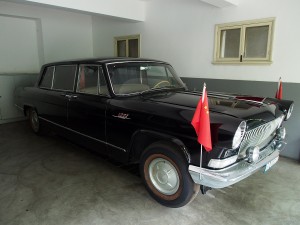From 24 June to 2 July 2014, I was in Shanghai, attending an academic/arts conference and seeing as much of the city as possible when not otherwise engaged. The meetings took place at Shanghai Jiao Tong University; jiao tong means “transportation” but is the equivalent of “polytechnic.” Many of the early technical universities in China were concerned with various forms of transportation. In the case of Shanghai Jiao Tong University, the major focus was maritime engineering; there is a massive rusted iron anchor in a courtyard between classroom buildings where there might be the statue of a humanist or political figure in another context. Shanghai, of course, is built on maritime traffic on the Yangtze River, the scale of which was evident in the massive materiality of the anchor. There were many such confrontations with massive scale in Shanghai, from its population of 23 million to the waves of public housing and corporate building that extend outward in all directions to its burgeoning infrastructure, particularly elevated highways and metro system. Jiao tong seems to have been an important concept. Now, it is being reinterpreted to include more liberal forms of scholarship, as witness the arts and humanities program that was our host. A canny citation of Confucian scripture permits this broader, more inclusive reading.
*****
My plan is to write paragraphs on the Shanghai experience during the continuation of my travels in Australia and New Zealand. Hence, there will be interruptions, but they will prevent the narrative from being too sequential or thematic. Rather, I will focus on various openings I experienced that gave me a greater insight into the contemporary phenomenon of China, which sooner or later anyone on earth must encounter and come to terms with—historically, politically, economically, aesthetically. Simply in terms of language, the Chinese ideogram is an entirely alternate mode of signification and meaning that calls into question one’s conventional understanding of how language works. One is faced as well with the modernization of a writing system that came down, as we know, from the pictographs of the bronze age to the establishment of a classical culture based in mastery of language and its attendant arts. After the establishment of the People’s Republic, the script was modified to raise levels of literacy, with the result that many of the more elaborate characters have taken simplified, iconic forms that facilitate semiotic processing. Along with that, however, was the establishment of a romanized phonetic system—the one we began to learn when Peking was rewritten as beijing about the time of Nixon’s visit in 1972. The phenomenal gap between iconic character and phonetic spelling means that one inculcates Chinese as a complex synthesis of visual recognition, phonetic spellings, and pronounced tones. I heard many Westerners perform excellent Chinese pronunciation at our conference; perhaps I too could attain competence in Chinese. Meanwhile I listened closely to language as spoken in institutional, public, conversational, everyday settings on a sliding scale of formality.
*****
The picture above is of the 1950s sedan presented by Joseph Stalin to Soong Ching-ling, widow of Sun Yat-sen and stalwart member of the party as it consolidated its power. Soong Ching-ling attended college in the U.S. and married Sun Yat-sen, who was quite a bit older, in 1915; he died in 1925, and she would survive him by decades. Sun Yat-sen was not only the promulgator of the “three principles” of the Chinese republic, but a major architect of its infrastructure, particularly railways and harbors; he sought to finance the construction of 200,000 li of railroads in the 1920s. As the widow of the founder of modern China, Soong Ching-ling had both a mission and significant clout; she continued the influence of the Third International and the politics of the Popular Front, even after the Shanghai massacre of 1927 when Chiang Kai-shek turned on the Communists in Shanghai. Very little of that moment is visible in several historical sites of that period I visited (site of the founding of the Chinese Communist Party; residences of Sun Yat-sen and Chou En-lai; and Soong’s house itself). Importantly, one of her sisters was Soong Mei-ling, who became Madame Chiang Kai-shek. I learned that it was after Soong Mei-ling’s trip to America in 1945 that Chiang decided to break with the Communists and attack them, thus leading to the civil war that the Communists won and that pushed Chiang to Taiwan. When I was living in Taiwan in the 50s, I remember Madame Chiang returning from New York on one of her shopping trips, surrounded by machine-gun toting guards and greeted by grandchildren with bouquets. There was, it turned out, scarcely any record of her in Soong Ching-ling’s residence (one studio photo; a few group portraits)—a history as family romance.
*****
[to be continued]













